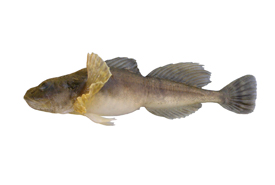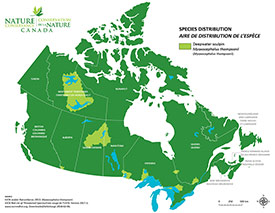
Deepwater sculpin (Photo by Doug Watkinson/Fisheries and Oceans Canada)
Deepwater sculpin
What does it look like?
The deepwater sculpin measures between 47 and 110 millimetres in length. It has a long, tapered body, blunt snout and flat head. Unlike other species in the sculpin family, the deepwater has two separated dorsal fins; the first has seven to 10 spines, the second has 11 to 16 soft rays with a long base and long fin rays. These rays are often larger on males.
In addition, this species has four preopercular (cheekbone) spines, with the upper two spines close enough to appear as one large spine. Gill membranes join at a sharp angle for additional protection and are free from the sculpin's breast.
Its tail fin is square, its pelvic fins are shaped like paddles and its pectoral fins are shaped like fans. The deepwater sculpin's body is scaleless, like most sculpins, but is prickled on top. It is generally grey-brown in colour with a lighter belly.
Where it is found?
The deepwater sculpin’s distribution is almost entirely limited to Canada, with the exception of the American regions of the Great Lakes. As its name suggests, the deepwater sculpin is a bottom-dwelling fish found in cold (< 7 C), well-oxygenated waters. It is found in more than 86 different lakes in Canada.
What does it eat?
Its diet consists of zooplankton and sometimes deepwater sculpin may prey on leeches, fish eggs and sphaeriid clams.
What is its conservation status?
According to Committee on the Status of Endangered Wildlife in Canada, the deepwater sculpin is considered threatened in Canada. The near extirpation (local extinction) of the deepwater sculpin from Lake Ontario has been linked to the introduction of alewife. Alewife has similar diets to the deepwater sculpin. The diminishing rates of zooplankton in the lower Great Lakes also poses a threat to the species, as it has to compete with alewife for an already limited amount of food.
Other threats to this species include habitat loss and degradation. In Quebec’s Heney Lake, the enrichment of the water with nutrients, known as eutrophication, subsequently lowered the oxygen levels needed to sustain the deepwater sculpin. This was a result of industrial, urban and agricultural developments by humans in areas populated by this sculpin.
What is NCC doing to protect habitat for this species?
The Nature Conservancy of Canada (NCC) and a number of other partners developed the Lake Superior Biodiversity Strategy, which provides a summary of the health of and threats to the biodiversity of Lake Superior, and presents a guide to implementing effective lake-wide and regional conservation strategies. This strategy contributes to the 2012 Great Lakes Water Quality Agreement commitment of developing lake-wide habitat and species protection and restoration conservation strategies.





